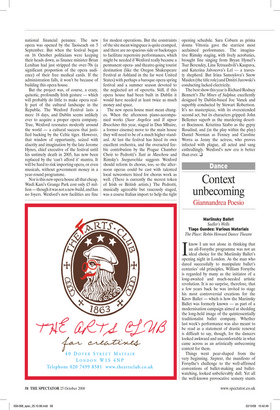Context unbecoming
Giannandrea Poesio
Mariinsky Ballet Sadler’s Wells Tiago Guedes: Various Materials The Place: Robin Howard Dance Theatre
Iknow I am not alone in thinking that an all-Forsythe programme was not an ideal choice for the Mariinsky Ballet’s opening night in London. As the man who dared successfully to manipulate ballet’s centuries’ old principles, William Forsythe is regarded by many as the initiator of a long-awaited and much-needed artistic revolution. It is no surprise, therefore, that a few years back he was invited to stage his most controversial creations for the Kirov Ballet — which is how the Mariinsky Ballet was formerly known — as part of a modernisation campaign aimed at shedding the long-held image of the quintessentially traditionalist ballet company. Whether last week’s performance was also meant to be read as a statement of drastic renewal is difficult to say, though, for the dancers looked awkward and uncomfortable in what came across as an artistically unbecoming context for them.
Things went pear-shaped from the very beginning. Steptext, the manifesto of Forsythe’s challenge to the well-affirmed conventions of ballet-making and balletwatching, looked unbelievably dull. Yet all the well-known provocative sensory stunts — lights that flood the entire auditorium when people expect to enjoy the ballet in semi-darkness, dancers that intentionally disappear from the viewer’s visual field, arbitrary use of Bach’s Chaconne etc. — as well as all of the choreographic innovations — asymmetrical ideas and quirkily off-balance acrobatics mixed with pedestrian actions — were there, duly performed on cue.
In my view, the overall flatness of the performance stemmed from both a lack of technical strength and a lack of interpretative drive on the dancers’ part. None of the artists seemed to have the technical prowess that all Forsythe’s ballets, and this one in particular, call for. Nor did they display the attack, as well as the subtle humour, that works such as Steptext rely so heavily on. Unfortunately, a lacklustre approach to such distinctive choreographic canons and a good amount of wobbly, insecure dancing also affected the other three items on the programme, Approximate Sonata, The Vertiginous Thrill of Exactitude and In the Middle, Somewhat Elevated.
Later in the week, the second programme on offer looked slightly better. Long before Forsythe, Russian-born George Balanchine had also adapted ballet’s old rules to his ingenious choreographic ideas. Created in 1928, and revised a trillion times, Apollo remains the undisputed perfect example of what 20th-century neo-classicism is and should be. It is a pity that neither a seasoned interpreter of the eponymous role such as Igor Zelensky, nor any of the pretty, but technically weak ballerinas who partnered him — Ekaterina Osmolkina, Nadezhda Gonchar and Olesya Novikova — could make the most of it. Only the (moderate) pyrotechnics of Vladimir Shklyarov and Evgenya Obratsova in Tchaikovsky’s Pas de Deux and those of blond bombshell Mikhail Lobukhin in Prodigal Son lifted the quality of an evening which edged dangerously on the brink of pure boredom. My only hope is that the modest group of dancers from the Mariinsky Ballet that I saw at Sadler’s Wells is not representative of the whole of the once almost legendary company.
Luckily, sheer fun was at hand at The Place, where the Portuguese artist Tiago Guedes showed one of his most acclaimed creations, Various Materials. At first, the piece looked like one of those infinitely tedious and ultra-dated pedestrian experimentations with daily movements that postmodern dance-makers have indulged in since the early Sixties. But then, as soon as the viewers’ patience reached the red-alert level, along came the unexpected twist. As suggested by the title, the artist conjured up a set, complete with mountain, clouds, rain, a river and a lake by using different everyday materials. The simplicity and the ingeniousness of the effect were irresistible, especially in light of the more esoteric-looking first section. Like everybody else I left the theatre feeling totally exhilarated, and looking forward to the artist’s second performance, scheduled to happen before this article will be in print. Like Toilet Tango and Transports Exceptionnels reviewed last week, Various Materials is pure theatre and another winning title in this year’s Dance Umbrella. ❑



















































































 Previous page
Previous page